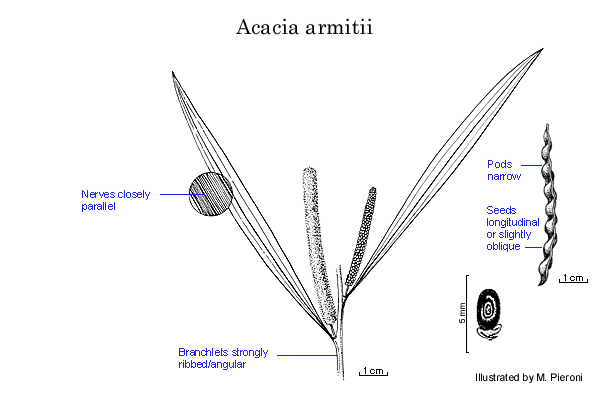Acacia armitii F.Muell. ex Maiden
WATTLE
Acacias of Australia
Family
Fabaceae
Distribution
Only known from the Einasleigh R. area in central-northern Qld and on a sandstone plateau S of Goomadeer, as well as Coopers Ck at Nabarlek, N.T.
Description
Shrub or slender tree to 7.5 m high. Branchlets prominently angled, fawn or yellowish, glabrous, resinous. Phyllodes ±erect, very narrowly elliptic to almost linear, flat, straight or very slightly incurved, (5–) 9–17 cm long, (4–) 6–17 mm wide, thinly coriaceous to coriaceous, yellow-green, ciliolate to ±glabrous, resinous; main nerves yellowish, with prominent midnerve and 1 subprominent nerve either side, with 6–10 minor parallel rarely anastomosing nerves per mm; gland basal, ±elliptic, c. 1 mm long. Peduncles glabrous or rarely subglabrous. Spikes solitary, axillary, yellow; receptacle with dense short patent hairs. Flowers 5-merous; calyx 0.6–0.8 mm long; sepals free, 0.05–0.1 mm wide, with rounded apices, pubescent; corolla 1.2–1.6 mm long, dissected to 2/5, with lower half pubescent especially on midrib; ovary pubescent. Pods erect, linear, straight-sided or very slightly constricted between seeds, undulate, straight, 2.7–5.5 cm long, 2.5–4.7 mm wide, yellowish brown, sparsely pubescent especially along margins, very resinous when young; margins ±prominent. Seeds 5–10, slightly oblique or longitudinal, broadly oblong to broadly elliptic, depressed dorsiventrally, 2–3.2 mm long, blackish brown; areole slightly paler, closed, with pale halo around pleurogram; funicle folded 2 or 3 times, cream-coloured.
Phenology
Flowers recorded July & Sept., fide G.J.Leach, Nuytsia 9: 362 (1994). Fruiting Aug.–Oct.
Habitat
Locally common in sandy or shallow, rocky soils, on creek banks and river flats.
Specimens
N.T.: Upper Goomadeer R. area, C.R.Dunlop 7228 & P.F.Munns (BRI, DNA, NSW, PERTH); Nabarlek, Coopers Ck, R.Hinz 596 (DNA, PERTH); 12º36'S, 133º19'E, M.Lazarides 7572 (NSW). Qld: c. 10 km S of the Einasleigh–Forsayth road on track leading to Robinhood Stn, J.R.Clarkson 2576 & N.B.Byrnes (BRI).
Notes
Acacia armitii differs from A. plectocarpa subsp. plectocarpa by having yellowish, more prominently angled stems, and narrower pods with smaller seeds. The seeds of the latter species are also often rotund to orbicular in outline. Acacia plectocarpa subsp. tanumbirinensis has narrower and usually longer phyllodes, while A. echinuliflora has narrower flower-spikes and wider pods than A. armitii. Acacia echinuliflora is also distinguished by having petals invested with an indumentum of dense, patent, yellow hairs, fide G.J.Leach, Nuytsia 9: 357 (1994). Without pods specimens of these species can be confused with A. torulosa, which differs mostly in having longer, moniliform, longitudinally wrinkled-ridged pods. Acacia torulosa is also more widespread than A. armitii and A. echinuliflora, and has branchlets soon becoming less angular to terete, unlike the more sharply angular ultimate branchlets of the latter two species.
FOA Reference
Data derived from Flora of Australia Volumes 11A (2001), 11B (2001) and 12 (1998), products of ABRS, ©Commonwealth of Australia
Author
P.G.Kodela
Minor edits by B.R.Maslin & J.Rogers
This identification key and fact sheets are available as a mobile application:
URL: https://apps.lucidcentral.org/wattle/
© Copyright 2018. All rights reserved.







